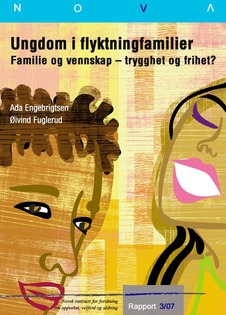| dc.description.abstract | Research on migrants and their adaptation processes and strategies only seldom differentiate between different ethnic groups of migrants. In order to understand the processes that influence adaptation it is, however, necessary to explore the complex conditions that form the basis for different groups. The main contribution of this project is to compare youth from 2 different refugee populations with different backgrounds and conditions in Norway, and to discuss whether and how these conditions influence the lives of young people. Tamil and Somali youths The main objective was to develop empirical knowledge about the living conditions of children and youth with refugee backgrounds in Norway. Based on our knowledge about the situation among Tamil and Somali families, our objective was to explore whether and how their situation influences the life of their children and to compare the situation of youth with Tamil and Somali backgrounds. We wanted to discuss relevant differences and similarities about the networks, families, friends and local belonging of these young people and about their self-understanding as youth in Norway. Interviews and survey data We carried out 36 interviews with 61 young people from 14 to 20 and 13 interviews with youth workers during 2005 and 2006. This report is also based on data from the NOVA survey Ungi Oslo 2006 (Young in Oslo), that is based on a questionnaire sent to pupils between 14 and 18 years in all schools in Oslo. Differences of the parent generation not reproduced The report concludes that youth with Tamil and Somali background do not appear to reproduce the differences of the parent generation. In spite of lower average education among Somalis and a lower average level of living than among Tamils in Norway, we find only small differences between the networks, school achievements and general joy of life between the two youth groups. More Tamil youth achieve a bit better at school than Somali youth, have very low scores of criminal and antisocial behaviour, while they generally have a bit higher scores for psychological problems such as loneliness and suicide attempts. More Somali boys on their side appear to have antisocial behaviour, such as criminal activity and drug use, but a smaller segment, both boys and girls, reports psychological problems, compared to the Tamils. More Somali boys do, however, also report about discrimination and racism than other groups. Parental control Both groups are, however, subject to more rigorous control from their parents and from their ethnic group in general than what is the case for other youths. Tamil youth appear to be more controlled than Somalis, and girls more than boys, something most of them describe as inhibiting, but secure. The strong loyalty these young people express towards their families and cultural background, combined with their explicit ambitions of getting an education, appear to constitute a safety net that obstructs antisocial behaviour while it also obstructs participation on many Norwegian arenas. We will describe this duality in terms of: wishing to be obedient towards one's family thereby strengthening belonging and protection on the one hand, and wishing to develop friendship and autonomy on the other that may threaten family cohesion and create insecurity. Our conclusion is that the joint effort of the young people themselves, their parents and school appears to decrease much of the social inequality experienced by their parents, but that these young people must face difficult choices that most young people with Norwegian backgrounds do not have to face. The report is written in Norwegian. | en |
| dc.description.abstract | Denne rapporten er utarbeidet for Redd Barna av Ada Engebrigtsen og Øivind Fuglerud og er den første rapporteringen fra intervjuundersøkelsen «Ungdom i flyktningfamilier» som er finansiert av Helse- og Rehabilitering. Rapporten er videre basert på utdrag fra NOVA-undersøkelsen Ung i Oslo 2006. De statistiske dataene fra Ung i Oslo 2006 er bearbeidet av Bera Moseng. Intervju-undersøkelsen omfatter 36 intervjuer med 61 ungdommer i Oslo og Tromsø, Ung i Oslo omfatter bl.a. statistisk materiale fra 166 ungdommer med bakgrunn fra Somalia og 164 med bakgrunn fra Sri Lanka, alle fra Oslo. Rapporten gir en bred beskrivelse av ungdom i flyktningfamilier, hovedsaklig med somalisk og tamilsk bakgrunn, slik de selv beskriver sider ved sine liv. Rapporten legger hovedvekten på spørsmål omkring familietilknytning og familieforhold, vennskap, fritid og nabolag, forhold til skole og lærere, tillitsforhold og opplevelse av inklusjon og eksklusjon, og betydningen, men også begrensningen ved etniske fellesskap. | no_NB |
